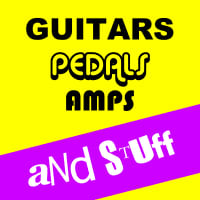Delay is a time-based guitar effect that produces echoes or repetitions of the original signal after a certain amount of time has passed. It works by recording the incoming audio signal and then playing it back with a slight delay, creating the perception of multiple instances of the sound occurring over time. Delay pedals typically offer controls for adjusting parameters such as delay time, feedback (the number of repeats), and level (the volume of the delayed signal). By manipulating these controls, guitarists can create a wide range of delay effects, from subtle ambiance to rhythmic patterns and spacious soundscapes. Delay is commonly used in various music genres, including rock, pop, ambient, and electronic music, to add depth, dimension, and texture to guitar solos, rhythm parts, and atmospheric passages. Popular delay pedal models include the TC Electronic Flashback, Boss DD-7 Digital Delay, and Strymon Timeline.
A pedal is a compact device that guitarists use to alter their instrument’s sound by shaping effects such as distortion, delay, reverb, and modulation. Typically housed in a rugged enclosure and controlled by footswitches, pedals are designed to be placed on the floor for hands-free operation during playing. They can be analogue or digital, true bypass or buffered, and come in countless varieties to suit different styles and preferences. Pedals are essential tools for creating signature tones and adding colour and texture to a guitarist’s sound.
Reverb, short for reverberation, is an essential guitar effect that simulates the natural reflections of sound in a physical space, such as a room, hall, or cathedral. It adds depth, ambiance, and spaciousness to the guitar’s sound by creating a series of discrete echoes that decay over time, mimicking the way sound reverberates in different environments. Reverb pedals offer controls for adjusting parameters such as decay time (the length of the reverb tail), pre-delay (the time between the original signal and the onset of the reverb), and mix (the balance between the dry and reverberated signals). By adjusting these parameters, guitarists can achieve a wide range of reverb effects, from subtle room ambience to lush, expansive reverberation. Reverb is widely used across various music genres, including rock, jazz, ambient, and electronic music, to add depth, dimension, and realism to guitar tones, creating a sense of space and immersion in the sound. Popular reverb pedal models include the Strymon BigSky, Boss RV-6, and Electro-Harmonix Holy Grail.
We have new and used Tone City musical equipment available on our website for fast direct delivery from sellers across the UK & Europe.
Tone City is a Chinese brand known for producing compact, affordable effects pedals with impressive sound quality. Their mini pedals cover a wide range of tones, from classic overdrives and delays to modern modulation and boost effects. Despite their small size and low price, Tone City pedals are well-regarded for their reliable build and great value, making them a popular choice for players building a space-saving or budget-friendly pedalboard.
£73.99
The Fender Hammertone Reverb Guitar Effect Pedal, meticulously crafted by Fender's in-house experts, delivers stunning ambience and echo; This pedal boasts three reverb modes and powerful controls, embodying Fender's rich heritage of innovation Original Fender-designed reverb pedal with Hall, Room, and Plate modes, each providing unique sounds for …
read more
£112.77
Reverb / delay effect pedal Combines a reverb section with a delay section Delay section with a variety of modulation options Up to 1200 ms delay time Control for Wet, Decay, Tone, Time, Mix, Depth, Speed, Repeat True Bypass Bypass foot switch for each section Status LED for each section Dimensions (L x W x H): 100 x 120 x 52 mm Weight: 350 g



